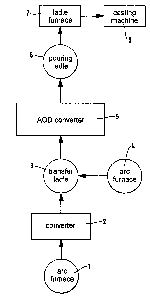Une partie des informations de ce site Web a été fournie par des sources externes. Le gouvernement du Canada n'assume aucune responsabilité concernant la précision, l'actualité ou la fiabilité des informations fournies par les sources externes. Les utilisateurs qui désirent employer cette information devraient consulter directement la source des informations. Le contenu fourni par les sources externes n'est pas assujetti aux exigences sur les langues officielles, la protection des renseignements personnels et l'accessibilité.
L'apparition de différences dans le texte et l'image des Revendications et de l'Abrégé dépend du moment auquel le document est publié. Les textes des Revendications et de l'Abrégé sont affichés :
| (12) Brevet: | (11) CA 2133918 |
|---|---|
| (54) Titre français: | METHODE ET DISPOSITIF SERVANT A PRODUIRE DE L'ACIER INOXYDABLE |
| (54) Titre anglais: | METHOD AND DEVICE FOR PRODUCING STAINLESS STEEL |
| Statut: | Durée expirée - au-delà du délai suivant l'octroi |
| (51) Classification internationale des brevets (CIB): |
|
|---|---|
| (72) Inventeurs : |
|
| (73) Titulaires : |
|
| (71) Demandeurs : |
|
| (74) Agent: | NORTON ROSE FULBRIGHT CANADA LLP/S.E.N.C.R.L., S.R.L. |
| (74) Co-agent: | |
| (45) Délivré: | 2002-02-12 |
| (22) Date de dépôt: | 1994-10-20 |
| (41) Mise à la disponibilité du public: | 1995-04-26 |
| Requête d'examen: | 1997-11-05 |
| Licence disponible: | S.O. |
| Cédé au domaine public: | S.O. |
| (25) Langue des documents déposés: | Anglais |
| Traité de coopération en matière de brevets (PCT): | Non |
|---|
| (30) Données de priorité de la demande: | ||||||
|---|---|---|---|---|---|---|
|
La présente invention concerne un procédé et un dispositif pour la production de l'acier inoxydable, comprenant des procédés de fabrication d'un ferro-alliage, tel que le ferrochrome, et pour le traitement ultérieur de l'alliage afin de produire un acier inoxydable souhaité. Selon l'invention, la masse fondue obtenue à partir de l'unité de production de ferro-alliages (1) est transférée au moins en partie à une unité de traitement de ferro-alliages (2) disposée entre l'unité de production de ferro-alliages (1) et l'unité de production d'acier inoxydable (5); dans ladite unité de traitement (2), la composition du ferro-alliage est ajustée pour convenir à la production de l'acier inoxydable.
The invention relates to a method and device for producing stainless steel, comprising methods for creating a ferro- alloy, such as ferrochromium, and for further processing the alloy in order to produce a desired stainless steel. According to the invention, the melt obtained from the ferro- alloy production unit (1) is transferred at least partly to a ferroalloy processing unit (2) arranged in between the ferroalloy production unit (1) and the stainless steel production unit (5); in the said processing unit (2), the composition of the ferroalloy is adjusted to be suitable for the production of stainless steel.
Note : Les revendications sont présentées dans la langue officielle dans laquelle elles ont été soumises.
Note : Les descriptions sont présentées dans la langue officielle dans laquelle elles ont été soumises.

2024-08-01 : Dans le cadre de la transition vers les Brevets de nouvelle génération (BNG), la base de données sur les brevets canadiens (BDBC) contient désormais un Historique d'événement plus détaillé, qui reproduit le Journal des événements de notre nouvelle solution interne.
Veuillez noter que les événements débutant par « Inactive : » se réfèrent à des événements qui ne sont plus utilisés dans notre nouvelle solution interne.
Pour une meilleure compréhension de l'état de la demande ou brevet qui figure sur cette page, la rubrique Mise en garde , et les descriptions de Brevet , Historique d'événement , Taxes périodiques et Historique des paiements devraient être consultées.
| Description | Date |
|---|---|
| Inactive : Périmé (brevet - nouvelle loi) | 2014-10-20 |
| Inactive : CIB de MCD | 2006-03-11 |
| Inactive : CIB de MCD | 2006-03-11 |
| Inactive : CIB de MCD | 2006-03-11 |
| Accordé par délivrance | 2002-02-12 |
| Inactive : Page couverture publiée | 2002-02-11 |
| Préoctroi | 2001-11-20 |
| Inactive : Taxe finale reçue | 2001-11-20 |
| Un avis d'acceptation est envoyé | 2001-10-19 |
| Un avis d'acceptation est envoyé | 2001-10-19 |
| month | 2001-10-19 |
| Lettre envoyée | 2001-10-19 |
| Inactive : Approuvée aux fins d'acceptation (AFA) | 2001-09-21 |
| Modification reçue - modification volontaire | 2001-08-20 |
| Inactive : Dem. de l'examinateur par.30(2) Règles | 2001-03-07 |
| Inactive : CIB en 1re position | 2000-07-13 |
| Inactive : Acc. réc. RE - Pas de dem. doc. d'antériorité | 1997-11-28 |
| Inactive : Dem. traitée sur TS dès date d'ent. journal | 1997-11-26 |
| Inactive : Renseign. sur l'état - Complets dès date d'ent. journ. | 1997-11-26 |
| Exigences pour une requête d'examen - jugée conforme | 1997-11-05 |
| Toutes les exigences pour l'examen - jugée conforme | 1997-11-05 |
| Demande publiée (accessible au public) | 1995-04-26 |
Il n'y a pas d'historique d'abandonnement
Le dernier paiement a été reçu le 2001-10-04
Avis : Si le paiement en totalité n'a pas été reçu au plus tard à la date indiquée, une taxe supplémentaire peut être imposée, soit une des taxes suivantes :
Les taxes sur les brevets sont ajustées au 1er janvier de chaque année. Les montants ci-dessus sont les montants actuels s'ils sont reçus au plus tard le 31 décembre de l'année en cours.
Veuillez vous référer à la page web des
taxes sur les brevets
de l'OPIC pour voir tous les montants actuels des taxes.
Les titulaires actuels et antérieures au dossier sont affichés en ordre alphabétique.
| Titulaires actuels au dossier |
|---|
| OUTOKUMPU STEEL OY |
| Titulaires antérieures au dossier |
|---|
| EERO RATTYA |
| JORMA KEMPPAINEN |
| MATTI HONKANIEMI |
| RISTO PELLIKKA |
| VEIKKO JUNTUNEN |